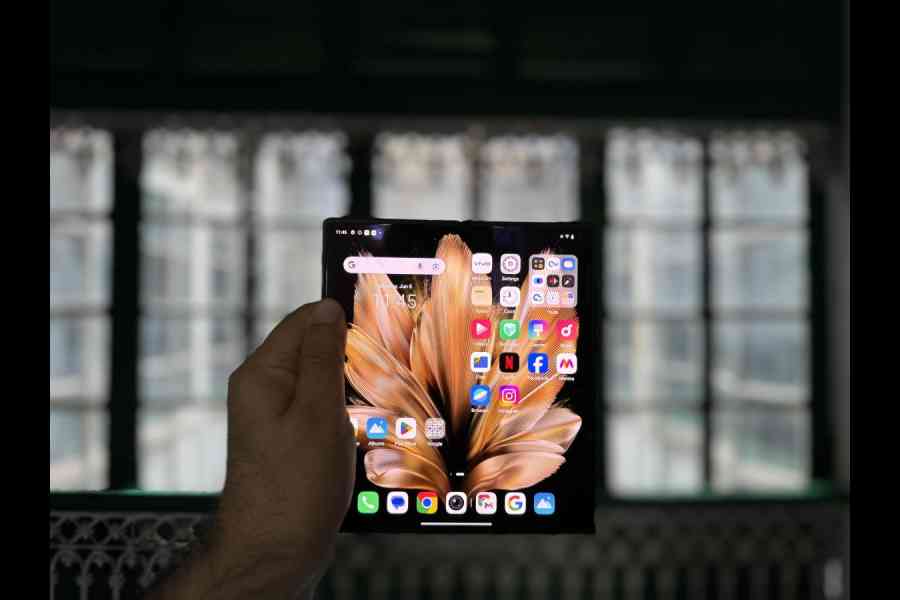Why should anybody get a foldable phone, a category that has been around for a few years now? It’s fun, unique, portable but who is it for? When the foldable category launched it was aimed at early tech adopters but, over the past few years, such devices are targeting people with high levels of productivity (being able to multitask on a larger display) and those who want the ultimate portability with a large screen.
Vivo has a new option in the market — Vivo X Fold3 Pro, which takes the competition straight to the Samsung Galaxy Z Fold series (Samsung is expected to launch its next series of foldable devices in a few weeks). The phone opens like a book — the 6.53-inch outer screen evolves into 8.03 inches.
The tech analysts at TrendForce say foldable phones will represent around 1.5 per cent of the global smartphone market by the end of 2024, but grow to five percent by 2028 after Apple enters the race, though the Tim Cook-led company hasn’t said anything about entering the category.
If we keep 2028 in mind, one wonders what’s stopping people from buying a new form factor, besides being costly. First, there has always been the issue with the display — a visible crease running top to bottom. Second, reparability because foldable phones are slightly more difficult to fix. Third, dust gathering around the screen. Fourth, there needs to be reason enough for us to “open” the phone and turn it into a tablet-like device.
Does Vivo address all these issues on its latest phone? Let’s find out.
Taking care of compromises
Vivo tackles three of the gripes against the foldable to a large degree. There is usually a “crease” running down from the top to the bottom of a phone; it’s there because of the type of screen and it’s improving drastically over the years. There is a slight crease on the Vivo phone but — like on the Samsung Galaxy Z device — users tend to ignore it after using the phone for 10-odd minutes.

Vivo hasn’t cut corners when it comes to pro photography options on the phone, flexing its camera partnership with Zeiss
Second, battery life. Since folding phones are directed towards a certain crowd, which believes in working on two or three apps simultaneously, battery consumption is more than usual. But Vivo’s device easily lasts a day.
In fact, Vivo hasn’t made compromises in terms of hardware. Users get Snapdragon 8 Gen 3 processor, 4,500 nits of local peak brightness, and 120Hz refresh rate on both AMOLED screens. Combine this with a 6.53-inch outer screen with a normal aspect ratio (21:9) and when you open it up, there is a large 8.03-inch main screen, with a thickness of just 5.2mm (in “open” condition and measured away from the camera bump), yet it has a 5,700mAh battery with fast charging.
Being lightweight (236g), users are able to hold the phone in its “open” state longer and, indirectly, work longer.
Third, in its “closed” format, the phone looks exactly like a normal smartphone. Samsung’s has a slightly tall format while OnePlus Open is slightly shorter. In other words, no compromises need to be made while viewing content on the outer or the main display. Further, when shut, the two halves of the display don’t have any space between them.
Let’s get deeper
A lot of thinking must have gone into the folding mechanism to ensure you use the phone for several years. The phone can be used in tent mode to watch content or you can keep open in half to view YouTube or have a video call. It’s a sturdy hinge.
A quibble: It takes some effort to “open” the phone. In the case of OnePlus or Samsung, less effort is needed to unfold. More the effort is needed to unfold, the fewer times I may unfold.

Vivo X Fold3 Pro can easily handle three tasks simultaneously
Since Vivo wants this to be the daily driver for all users, the company has thrown in a good set of cameras.
Keeping the front 32MP FF (cover screen) and the 32MP FF (main screen) snappers company are a trio of cameras on the back — 50MP (OIS) VCS, 50MP wide-angle AF and 64MP telephoto (OIS) with 3x optical zoom.
Vivo has worked with Zeiss to make the cameras shine. The main camera does well and given the pricing, it better shine. The optical image stabilisation helps while taking videos and photos while pictures come out crisp and colours have a natural feel to it. Make sure you have got all the updates in place to get the maximum out of the camera. Using the rear camera, it is possible to shoot 4K@60fps as well as in 8K. But on the selfie cameras (both outside and inside), video is only at 1080p and I am not sure why this is the case on a flagship phone. One may argue that you can shoot higher-quality videos using the back camera and all you have to do is turn the phone around. I don’t buy into the logic because when you are paying an eye-watering amount, there has to be higher specs. Overall, Zeiss colours are natural and true to life while white balance is quite good. While zooming, up to 6x photos are useable but at 10x the quality deteriorates. Low-light phots are among the best you will get on a folding phone.
All about performance
However, a foldable phone should be seen more in terms of workflow. What has Vivo done differently? I like the presence of a dock system to ensure quick accessibility to apps. The software running the show is Android 14 and on top of that is Funtouch OS 14.
There is the option of setting up a display showing all the apps you want on the outside screen and when you unfold, there is also another set of apps on the righthand side of the display. It’s helpful.
There are some pre-installed apps, like Myntra, Facebook and Netflix. These should have been left out of a premium device. Personally, I don’t shop on Myntra and I don’t have Netflix installed on my phone. As for Facebook, it’s great for finding birthdays of friends and colleagues. You can, of course, uninstall them.

On the video front, the selfie camera shoots at 1080p
Winning a brownie point are the widgets and also the smooth experience of using the keyboard, even in split screen mode.
When it comes to running apps simultaneously, you can switch to “split screen”. Also present is the option to “switch to small window”.
I won’t get into the processor because Snapdragon 8 Gen 3 has a proven track record. It will easily last you a few years and ensure games run at top speeds and settings. A good use case of foldable phones is watching content.
Having a large screen and excellent speaker system translate into streaming heaven on the move. I rarely had to turn up the volume to 100 per cent because the speakers are well tuned.
The thermals are also topnotch and even after gaming for one hour or so, the phone didn’t get unexceptionally hot.
Should you buy it?
Google has been making progress to offer folding phones new features and better UI but somehow that’s still not there. Samsung has managed to get around it with a different software implementation. Otherwise, there are many apps that are not optimised for the big screen. Second, a couple of companies have managed to build their ecosystems so well that many consumers own several products from these brands, so moving files and work between devices become easier.

You get a very bright display on Vivo’s folding phone
Keeping these aside, Vivo has excelled in terms of battery life, which is easily seven hours of screen-on time. And that Vivo is giving wireless charging up to 50W deserve a mention. I have no doubt that even if you fold-unfold the phone around 80-100 times a day, the phone will easily last plenty of years. Vivo has also put in enough effort to make the device among the best in the camera department. But it could have done better than four years of security update and three years of software updates. Sure, we have to wait longer to get a foldable phone that’s almost perfect but Vivo X Fold3 Pro is a commendable and meaningful effort.
At a glance
Device: Vivo X Fold3 Pro
Price: Rs 159,999
High notes
Very good hardware
Excellent camera
Both displays are sharp
Outstanding battery life
Muffled notes
Video on selfie camera restricted to 1080p
There is a slight crease on the main screen (like on all other folding phones)
Google needs to put in more effort to improve Android experience on the big screen











